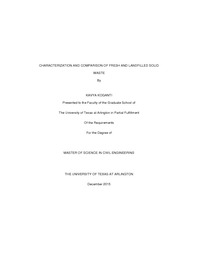
ATTENTION: The works hosted here are being migrated to a new repository that will consolidate resources, improve discoverability, and better show UTA's research impact on the global community. We will update authors as the migration progresses. Please see MavMatrix for more information.
Show simple item record
| dc.creator | Koganti, Kavya | |
| dc.date.accessioned | 2016-01-26T23:44:40Z | |
| dc.date.available | 2016-01-26T23:44:40Z | |
| dc.date.created | 2015-12 | |
| dc.date.issued | 2015-12-07 | |
| dc.date.submitted | December 2015 | |
| dc.identifier.uri | http://hdl.handle.net/10106/25463 | |
| dc.description.abstract | The understanding of the characteristics of Municipal Solid Waste (MSW) is very important in planning, designing and operating and/or upgrading the landfill operation system. It is well anticipated that the fresh MSW will be different from the landfilled MSW due to degradation. However, there is no systematic study on the comparison of physical properties of fresh and landfilled waste from bioreactor and/or enhanced leachate recirculated (ELR) landfills. The most important MSW properties to be considered while planning a landfill system are physical composition, moisture content, unit weight and volatile solids content. These properties are of particular interest especially when an enhanced leachate recirculation (ELR) landfill is operated because they help to determine the amount of moisture to be recirculated and to design the leachate recirculation and gas collection systems.
The current study presents the physical and hydraulic properties of landfilled and fresh MSW from the City of Denton Landfill from samples collected in 2014 and 2015 from cell 0, cell 2 and cell 3. The approximate age of the MSW collected from cell 0, cell 2 and cell 3 are 9 to 25 years, 5-6 years and 5-8 years respectively. According to the results of physical composition, the content of soils and fines were much higher in the landfilled waste than the fresh waste. The range of soils and fines waste for the landfilled waste was 40% to 50% approximately, while for the fresh waste it was 35%. As the landfilled waste has a protective cover on top, it can be explained why it has more soils and fines content than the fresh waste. The content of paper and food waste is much higher in fresh waste than in the landfilled and the reason for this could be because the landfilled waste gets decomposed with time while the fresh waste is waste collected from household garbage. The paper waste for landfilled samples ranged from 13% to 20% while for the fresh waste the paper waste was 34%. The food waste for landfilled samples was almost 0% in all cases while for the fresh waste the average was 3%. The difference between the content of metals of fresh and landfilled waste was negligible. The compressible components of the MSW decreased with an increase in the age of the waste.
The average moisture content of fresh waste was higher than that of landfilled waste. The reason for higher moisture content in the fresh waste could be because of the presence of higher organic components in the waste.
The average compacted unit weight was higher for landfilled samples compared to fresh samples. This might be due to the presence of higher compaction that occurs to landfilled waste. This study of moisture content and solids content in the landfills help the design of slopes without failure because it has direct impact on the geotechnical stability of landfills according to several historic slope failures (e.g., Hendron et al. 1999; Eid et al. 2000).
The volatile solids content of landfilled samples ranged from 18% to 30% and the average volatile solids content for fresh waste was 41% which shows that the landfilled waste is more degraded than the fresh waste. | |
| dc.format.mimetype | application/pdf | |
| dc.language.iso | en_US | |
| dc.subject | Fresh waste | |
| dc.subject | Landfill waste | |
| dc.subject | Municipal solid waste | |
| dc.subject | ERL landfill | |
| dc.subject | Conventional landfill | |
| dc.subject | Compare | |
| dc.title | Characterization and comparison of fresh and landfilled solid waste | |
| dc.type | Thesis | |
| dc.date.updated | 2016-01-26T23:44:40Z | |
| thesis.degree.department | Civil Engineering | |
| thesis.degree.grantor | The University of Texas at Arlington | |
| thesis.degree.level | Masters | |
| thesis.degree.name | Master of Science in Civil Engineering | |
| dc.type.material | text | |
| dc.creator.orcid | 0000-0002-2584-9663 | |
Files in this item
- Name:
- KOGANTI-THESIS-2015.pdf
- Size:
- 2.912Mb
- Format:
- PDF
This item appears in the following Collection(s)
Show simple item record


